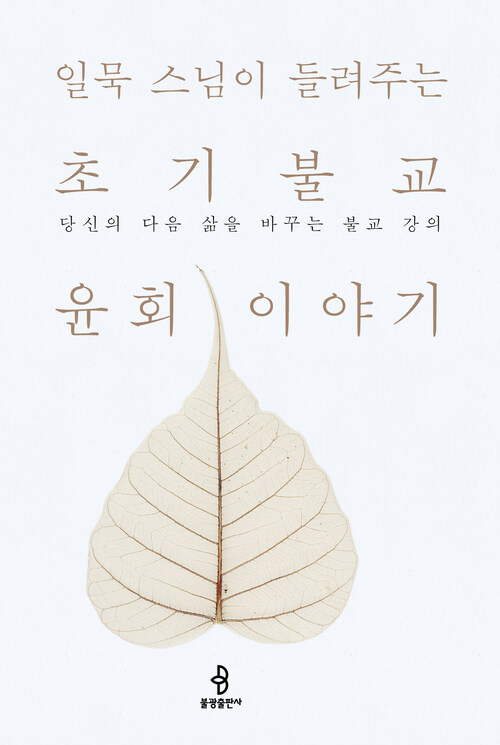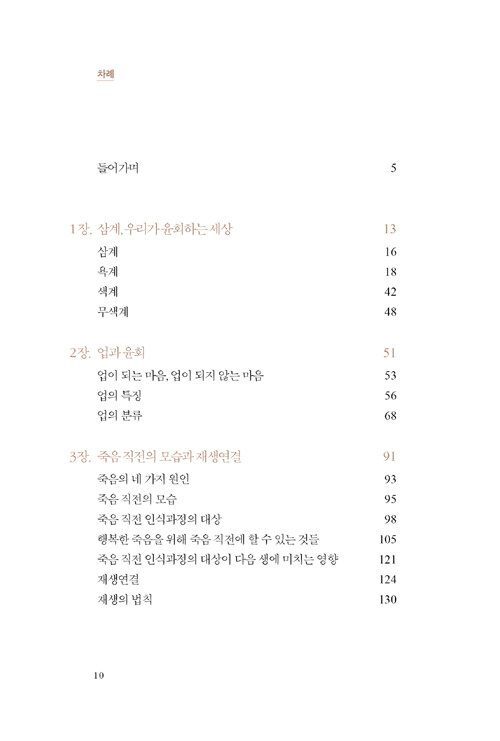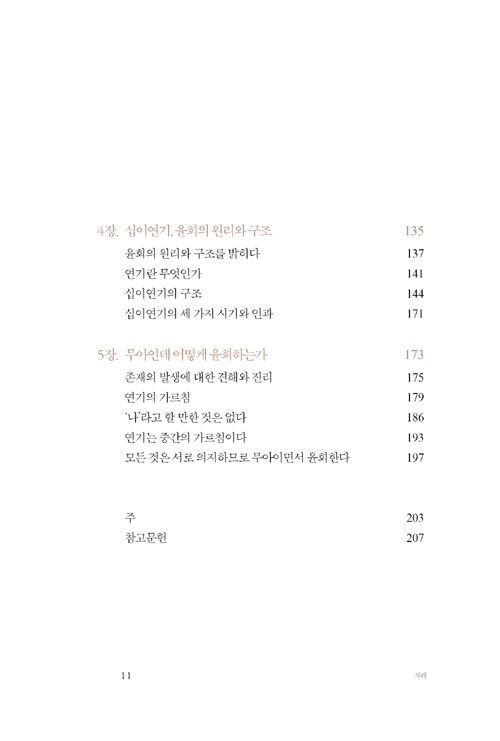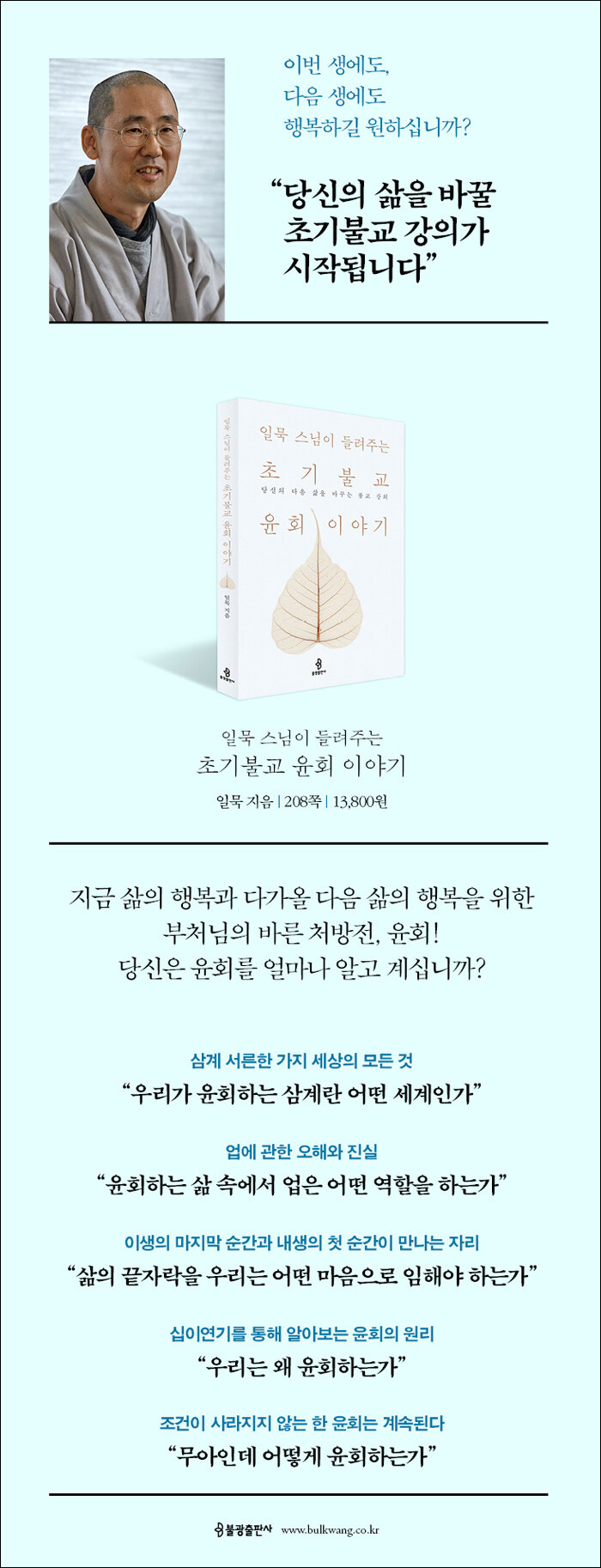일묵 스님이 들려주는 초기불교 윤회 이야기 : 당신의 다음 삶을 바꾸는 불교 강의 - 당신의 다음 삶을 바꾸는 불교 강의


일묵 (지은이)불광출판사2019-09-06



































종이책 페이지수 208쪽,
책소개
우리는 누구나 행복한 삶을 원한다. 하지만 행복한 삶을 살지 못한다. 그 이유는 행복한 삶으로부터 멀어지는 불선(不善)한 행위를 하며 살고 있기 때문이다. 게다가 우리 스스로 짓는 매순간의 업이 어떤 결과를 가져오는지 알지 못하니 많은 이들은 이생의 끝을 두려워하며 고통스러운 삶을 살 수밖에 없다.
불교에서는 모든 고통과 번뇌의 원인 중 하나를 무명이라 이야기한다. 마치 한 치 앞도 보이지 않는 어둠 속에서 길을 헤매듯 진리의 빛을 얻지 못하고 잘못된 길로 나아가게 되는 것이다. 그럼 우리는 현생과 내생의 행복을 위해 무엇을 알아야 하는가? 그리고 어떻게 살아야 하고, 어떻게 이생의 끝을 마무리해야 하는가? 그것은 윤회의 가르침 안에 모두 담겨 있다.
이 책은 초기불교의 가르침을 중심으로 윤회의 개념과 원리에 대해 설명한다. 지난 2010년 출간된 스님의 첫 책이자 많은 독자들에게 사랑 받은 『윤회와 행복한 죽음』의 개정판이기도 한 이 책은 새로운 옷과 새로운 구성으로 그동안 허황된 내세관으로만 치부되었던 윤회의 진정한 의미는 무엇인지 독자들로 하여금 선명하고 바른 시각을 가질 수 있도록 인도한다.
목차
들어가며
제1장 삼계, 우리가 윤회하는 세상
삼계
욕계
색계
무색계
제2장 업과 윤회
업이 되는 마음, 업이 되지 않는 마음
업의 특징
업의 분류
제3장 죽음 직전의 모습과 재생연결
죽음의 네 가지 원인
죽음 직전의 모습
죽음 직전 인식과정의 대상
행복한 죽음을 위해 죽음 직전에 할 수 있는 것들
죽음 직전 인식과정의 대상이 다음 생에 미치는 영향
재생연결
재생의 법칙
제4장 십이연기, 윤회의 원리와 구조
윤회의 원리와 구조를 밝히다
연기란 무엇인가
십이연기의 구조
십이연기의 세 가지 시기와 인과
제5장 무아인데 어떻게 윤회하는가
존재의 발생에 대한 견해와 진리
연기의 가르침
‘나’라고 할 만한 것은 없다
연기는 중간의 가르침이다
모든 것은 서로 의지하므로 무아이면서 윤회한다
주
참고문헌
접기
책속에서
첫문장
우리가 업을 지으면 그 업의 종류에 따라 다음 생에 태어나는 세상이 달라집니다.
P. 15 우리가 삼계에 대해 알게 되면 ‘저곳은 갈 만한 곳이다.’, ‘저곳은 절대 가지 말아야 할 곳이다.’라는 생각을 하게 됩니다. 그리고 윤회의 굴레에서 벗어나지 못하고 끝없이 돌고 도는 세상이 어떤 모습인지를 알게 되어, ‘인간 몸 받았을 때 열심히 수행해 악처에 가는 일을 없게 하고 빨리 윤회에서 벗어나야겠다.’라는 경각심이 일어납니다. 접기
P. 18 경전에는 삼계화택三界火宅이란 말이 있습니다. ‘삼계가 다 불타는 집과 같다’는 뜻입니다. 욕계·색계·무색계가 즐거움이나 고통이 많고 적은 차이는 있지만, 이 셋 모두 중생, 즉 윤회의 괴로움에서 벗어나지 못한 존재들이 사는 세상이라는 점에서는 같습니다. 우리가 아라한이 되기 전까지는 원하든 원하지 않든 이 삼계를 끊임없이 떠돌게 됩니다. 때로는 좋은 곳에 태어나 즐거움을 누리고, 때로는 나쁜 곳에 태어나 극심한 고통을 겪는 것이 계속 반복됩니다. 경전에 보면 중생이 윤회하면서 흘린 눈물과 피가 지구상에 있는 바닷물보다도 많다고 했습니다. 이 삼계를 벗어나는 것, 그것이 바로 우리가 수행을 하는 목적입니다. 접기
P. 35 욕계에는 인간계보다 즐거움이 훨씬 많은 천상계가 있습니다. 『법구경』 주석서를 비롯한 여러 경전에는 계율을 지키고 보시를 행해서 욕계 천상계에 태어난 예가 많이 나옵니다. 욕계 천상계에는 여섯 가지가 있는데 제일 낮은 천상계가 사천왕천이고, 그 다음이 삼십삼천三十三天, 야마천夜摩天, 도솔천兜率天, 화락천化樂天, 타화자재천他化自在天입니다. 접기
P. 41 부처님의 상수제자 중 한 명인 목갈라나[目犍連] 존자는 신통제일神通第一이라고 불립니다. 목갈라나 존자는 가끔씩 삼십삼천에 올라가서 천인들을 만나 어떤 공덕을 지어 천상계에 왔는지 물어보고 다시 인간 세상에 내려와서 수행자들에게 가르쳐 주곤 했습니다. 목갈라나 존자가 한 천인에게 무슨 공덕으로 천상계에 왔느냐고 물으니 그 천인은 처음에는 말을 안 하다가 결국 “저는 무 한 조각을 스님께 보시해서 이곳에 태어났습니다.”라고 말했습니다. 그 말을 들은 목갈라나 존자가 부처님께 그런 사소한 공덕으로도 천상계에 태어날 수 있냐고 여쭈어 보니 부처님은 “네 눈으로 직접 보고 듣지 않았느냐?”라고 말씀하셨습니다. 실제로 아주 사소한 보시도 바른 신심을 가지고 기쁜 마음으로 행하면 그로 인해 욕계 천상계에 태어날 수 있습니다. 접기
P. 53 삼계 혹은 서른한 가지 세상에 태어나게 하는 가장 강력한 조건은 바로 갈애渴愛[taṇha]와 업業[kamma]입니다. 업을 이해하면 윤회가 일어나는 과정을 이해하는 데 큰 도움이 됩니다.
부처님께서는 ‘의도’를 업이라고 말씀하셨습니다. 『앙굿따라 니까야』의 「꿰뚫는 경」에 보면 “나는 의도를 업이라고 말한다. 몸과 말과 마음으로 업을 짓는다.”고 나옵니다. 엄밀하게 말하면 업은 선한 마음이나 불선한 마음의 의도라고 할 수 있습니다. 접기
더보기
저자 및 역자소개
일묵 (지은이)
저자파일
최고의 작품 투표
신간알림 신청
해인사 백련암에서 원택 스님을 은사로 출가하였다. 범어사 강원을 졸업했고 봉암사, 미얀마 파욱국제명상센터, 영국 아마라와띠, 프랑스 플럼빌리지 등 국내와 세계 불교 수행처에서 수행하였다. 2009년 서울에 초기불교의 가르침을 전하는 제따와나선원을 개원하였고, 2018년 강원도 춘천에 수행 도량을 마련하여 이전하였다. 현재 춘천 제따와나선원의 선원장으로 머물며 부처님의 가르침을 전하고 있다. 저서로 『이해하고 내려놓기』, 『일묵 스님이 들려주는 초기불교 윤회 이야기』 등이 있다.
최근작 : <일묵 스님이 들려주는 초기불교 윤회 이야기 (큰글자책)>,<사성제 (큰글자책)>,<사성제> … 총 9종 (모두보기)
출판사 제공 책소개

초기불교의 가르침을 통해 알아보는 윤회의 개념과 원리
지금 삶의 행복과 다가올 다음 삶의 행복을 위한
부처님의 바른 처방전, 윤회(輪廻)
당신은 윤회를 얼마나 알고 있습니까?
•윤회란 무엇이고, 그 원리는 무엇인가
•우리가 윤회하는 삼계란 어떤 세계인가
•윤회하는 삶속에서 업은 어떻게 작용하는가
•이생과 내생의 행복을 위해 우리는 무엇을 알고, 무엇을 준비해야 하는가
우리는 누구나 행복한 삶을 원한다. 하지만 행복한 삶을 살지 못한다. 그 이유는 행복한 삶으로부터 멀어지는 불선(不善)한 행위를 하며 살고 있기 때문이다. 게다가 우리 스스로 짓는 매순간의 업이 어떤 결과를 가져오는지 알지 못하니 많은 이들은 이생의 끝을 두려워하며 고통스러운 삶을 살 수밖에 없다.
불교에서는 모든 고통과 번뇌의 원인 중 하나를 무명(無明)이라 이야기한다. 마치 한 치 앞도 보이지 않는 어둠 속에서 길을 헤매듯 진리의 빛을 얻지 못하고 잘못된 길로 나아가게 되는 것이다. 그럼 우리는 현생과 내생의 행복을 위해 무엇을 알아야 하는가? 그리고 어떻게 살아야 하고, 어떻게 이생의 끝을 마무리해야 하는가? 그것은 윤회(輪廻)의 가르침 안에 모두 담겨 있다.
이 책의 저자인 일묵 스님은 1996년 서울대 수학과 박사 과정 중 출가하여 성철 큰스님의 제자인 원택 스님을 스승으로 모셨다. 이후 불교 명상에 관심이 있는 이라면 한 번쯤은 들어봤을 국내외 여러 수행처를 다니며 지속적인 수행을 하였다. 그리고 현재 초기불교 수행법을 전하는 수행공동체인 제따와나 선원을 활발히 운영하고 있는 선원장이기도 하다.
스님의 저서인 『일묵 스님이 들려주는 초기불교 윤회 이야기』는 초기불교의 가르침을 중심으로 윤회의 개념과 원리에 대해 설명한다. 지난 2010년 출간된 스님의 첫 책이자 많은 독자들에게 사랑 받은 『윤회와 행복한 죽음』의 개정판이기도 한 이 책은 새로운 옷과 새로운 구성으로 그동안 허황된 내세관으로만 치부되었던 윤회의 진정한 의미는 무엇인지 독자들로 하여금 선명하고 바른 시각을 가질 수 있도록 인도한다.
당신에게 윤회란 무엇입니까
일반적으로 윤회는 다음 몇 가지로 인식된다.
먼저 허황된 이야기라는 측면이다. 스님은 이 책의 머리말에서 다음과 같이 이야기한다.
“제따와나 선원을 개원하고 많은 사람을 만나면서 새삼 알게 된 사실이 한 가지 있습니다. 그것은 윤회를 믿지 않는 불자가 의외로 많다는 것입니다.”
우리는 눈에 보이는 것만 믿는 경향이 있다. 하지만 눈에 보이지 않는 것이라 할지라도 윤회가 우리의 삶과 수행을 올바른 방향으로 이끌어 가는 데 중한 역할을 한다는 점은 분명하다. 그것을 알고 바른 실천을 행함으로써 진정한 행복을 얻을 수 있고, 궁극적으로 열반을 실현할 수 있다는 것이 이 책 전반에 배어 있는 일묵 스님의 메시지이다.
또한 잊지 말아야 할 것은 윤회는 삶의 끝자락에서만 작동하는 원리가 아니라는 점이다. 다시 말해 지금의 삶 속에서도 끊임없이 작동하고 있다는 것이다. 윤회의 원리로서 ‘이것이 있으므로 저것이 있다’, 즉 “연기(緣起)”를 설하고 계신 부처님의 가르침을 다시금 되새겨봐야 한다.
둘째, 짐짓 죽음과 연관되어 무겁거나 어두운 개념으로 인식된다. 언젠가는 누구에게나 닥칠 죽음이다. 하지만 ‘나’에 대한 집착은 끝내 죽음에 대한 공포심을 일으킨다. 또한 한 번도 가 본 적 없는 죽음 이후의 세계에 대해 두려움을 느끼기도 한다.
이 책을 한 줄 한 줄을 읽다 보면 그 공포나 두려움은 결국 나로부터 시작되고, 나로부터 극복될 수 있음을 알 수 있게 된다. 그리하여 우리 삶의 태도를 바꾸고 더 나은 길로 향하는 길을 찾을 수 있는 것이다.
그렇다면 두려움을 극복하고 지금의 삶과 다가올 다음의 삶의 행복을 위해 우리는 무엇을 어떻게 해야 하는가.
당신의 현생과 내생의 행복을 위한 윤회 강의
우선 알아야 한다. 윤회란 무엇인지, 윤회가 계속 반복된다는 삼계(三界)란 세계는 어떤 공간인지, 윤회와 부처님의 핵심적 가르침들, 이를테면 업과 십이연기 등은 어떻게 연결되는지에 대해서 말이다. 하지만 어렵고 딱딱하기만 할 것만 같다.
이 책의 특징 중 하나는 간명하고 깔끔한 서술로 하여금 이전의 그 어떤 책보다 쉽고 명확한 이해가 가능하다는 점이다. 그동안 윤회를 다룬 많은 책들은 학제적 성격을 갖거나 일반 독자들이 접하기에 다소 어려운 경우가 많았다. 하지만 이 책은 불교 교리에 해박하지 않은 독자들도 알기 쉽게 서술되어 있다. 윤회와 윤회를 둘러싼 개념에 대해 친절히 설명하고 있는 스님의 강의법도 그러하거니와 초기불교 경전과 주석서 등에서 길어 올린 인연담, 혹은 스님의 개인적인 인연담을 빌려 전달함으로써 초심자인 독자들도 바른 시각을 가질 수 있게 도운다.
다음으로 실천해야 한다. 이 책은 단순히 개념을 설명함에 머무르지 않고 왜 수행을 해야 하는지, 윤회의 순간순간 우리는 어떻게 살아야 하는지에 대해 알려준다. 예를 들어 불자로서 즐거움이 가득한 선처(善處)에 태어나기 위해 무엇을 수행해야 하는지, 생의 마지막 순간 어떤 마음을 가져야 하는지, 임종을 앞둔 가족을 위해 우리는 어떻게 행동해야 하는지 등에 대한 충고를 아끼지 않는 것이다.
그동안 궁금했던 윤회의 모든 것
- 오직 당신을 위한 일묵 스님의 강의 계획안
이 책의 각 장 내용을 요약하면 다음과 같다.
1장은 우리가 윤회하는 세상인 삼계, 즉 욕계·색계·무색계에 대해 풀었다. 우리는 윤회할 때 자기가 지은 업에 따라 삼계의 서른한 가지 세상 중 한 곳에 태어난다. 이 서른한 가지 세상의 다양한 모습을 알게 되면, 우리는 다음 생에 악처가 아닌 선처에 태어날 수 있도록 항상 경각심을 가지게 될 것이다.
2장은 업과 윤회에 대해 다루었다. 업에 의해 윤회가 일어난다는 것은 알지만 업의 개념을 명확하게 이해하는 사람은 그리 많지 않다. 업의 역할, 과보를 생산하는 장소, 업이 결과를 맺는 순서와 시기 등에 관한 폭넓고 정확한 이해를 통해 업에 대한 잘못된 견해를 버릴 수 있다.
3장에서는 죽음 직전의 인식과정에 나타난 업에 의해 내생의 첫 의식, 즉 재생연결식이 어떻게 일어나는지에 대해 설명했다. 우리가 일생에 지은 업 중 가장 뚜렷한 업이 죽음 직전의 인식과정에서 업이나 업의 표상, 태어날 곳의 표상 중 한 가지 형태로 나타난다. 그 업에 의해 내생에 태어날 세상이 결정되고, 그곳에서 최초로 재생연결식이 일어난다. 이 과정을 잘 이해하면 깨끗한 마음으로 죽음을 맞이하는 것이 얼마나 중요한지를 알 수 있다.
4장은 불교의 핵심 가르침인 연기에 대해 풀어썼다. 3장의 윤회의 원리를 십이연기의 가르침을 통해 체계적으로 정리한 부분이다. 연기를 이해하면 그릇된 견해를 버리고 바른 견해를 갖추어 궁극적으로 깨달음을 실현할 수 있을 것이다.
5장에서는 무아(無我)인데 윤회하는 이유가 존재는 연기, 즉 조건을 의지해서 태어나기 때문이라는 것에 관해 이야기했다. 연기를 통해 존재의 발생과 윤회의 원인을 이해하면 존재들은 서로 의지하고 있다는 것을 알 수 있으므로 자비심으로 세상을 바라볼 수 있다.
불교에서 가장 중요하고 핵심적인 가르침인 연기와 사성제(四聖諦) 등은 윤회를 기반으로 설해져 있다. 이 같은 점을 통해 윤회를 이해함이 불교를 이해함에 있어 얼마나 중요한 것인지 알 수 있다.
더구나 일묵 스님의 윤회 강의를 한 장 한 장 읽다 보면 그동안 얼마나 잘못된 생각을 가지고 살아왔고, 그 잘못된 생각이 우리 안에 얼마나 뿌리 깊이 박혀 있는지 깨닫게 된다. 또한 앞으로의 삶을 어떻게 살아야 할지에 대한 경각심도 생긴다.
우리는 일묵 스님의 이 책을 통해 윤회를 올바르게 이해함으로써 부처님께서 남기신 행복을 위한 또 하나의 처방전을 받아들일 수 있게 된다. 결국 우리에게 남은 건 행복뿐일 것이다. 접기
100자평
구매자 (2)
전체 (2)
공감순





부처님의 가르침을 듣고싶어도 정보가 난무하는 혼잡한 세상에서 핵심을 접할 길을 몰랐었어요.우연히 팟캐스트에서 일묵스님의 지루한? 강의를 듣다가 관심이 생겨서 책을 구입하고 읽었는데 읽고난 지금은 부처님의 가르침에 더 다가가고 싶고 선량하게 바르게 사는법을 배우고 싶어졌습니다.

우주 2019-05-04 공감 (1) 댓글 (0)
Thanks to
공감





최근 초기불교가 기존 대승불교에 실망한 많은 불자의 마음을 사로 잡고 있는데, 일묵스님도 불자들에게 많은 가르침을 주고 계신 분이십니다. 일묵스님의 윤회를 주제로한 이번 책은 초기불교의 핵심 가르침을 윤회를 중심으로 잘 전달하고 있느데, 감사할 따름입니다. 사두 사두 사두.

4장은 불교의 핵심 가르침인 연기에 대해 풀어썼다. 3장의 윤회의 원리를 십이연기의 가르침을 통해 체계적으로 정리한 부분이다. 연기를 이해하면 그릇된 견해를 버리고 바른 견해를 갖추어 궁극적으로 깨달음을 실현할 수 있을 것이다.
5장에서는 무아(無我)인데 윤회하는 이유가 존재는 연기, 즉 조건을 의지해서 태어나기 때문이라는 것에 관해 이야기했다. 연기를 통해 존재의 발생과 윤회의 원인을 이해하면 존재들은 서로 의지하고 있다는 것을 알 수 있으므로 자비심으로 세상을 바라볼 수 있다.
불교에서 가장 중요하고 핵심적인 가르침인 연기와 사성제(四聖諦) 등은 윤회를 기반으로 설해져 있다. 이 같은 점을 통해 윤회를 이해함이 불교를 이해함에 있어 얼마나 중요한 것인지 알 수 있다.
더구나 일묵 스님의 윤회 강의를 한 장 한 장 읽다 보면 그동안 얼마나 잘못된 생각을 가지고 살아왔고, 그 잘못된 생각이 우리 안에 얼마나 뿌리 깊이 박혀 있는지 깨닫게 된다. 또한 앞으로의 삶을 어떻게 살아야 할지에 대한 경각심도 생긴다.
우리는 일묵 스님의 이 책을 통해 윤회를 올바르게 이해함으로써 부처님께서 남기신 행복을 위한 또 하나의 처방전을 받아들일 수 있게 된다. 결국 우리에게 남은 건 행복뿐일 것이다. 접기
100자평
구매자 (2)
전체 (2)
공감순

부처님의 가르침을 듣고싶어도 정보가 난무하는 혼잡한 세상에서 핵심을 접할 길을 몰랐었어요.우연히 팟캐스트에서 일묵스님의 지루한? 강의를 듣다가 관심이 생겨서 책을 구입하고 읽었는데 읽고난 지금은 부처님의 가르침에 더 다가가고 싶고 선량하게 바르게 사는법을 배우고 싶어졌습니다.
우주 2019-05-04 공감 (1) 댓글 (0)
Thanks to
공감
최근 초기불교가 기존 대승불교에 실망한 많은 불자의 마음을 사로 잡고 있는데, 일묵스님도 불자들에게 많은 가르침을 주고 계신 분이십니다. 일묵스님의 윤회를 주제로한 이번 책은 초기불교의 핵심 가르침을 윤회를 중심으로 잘 전달하고 있느데, 감사할 따름입니다. 사두 사두 사두.

